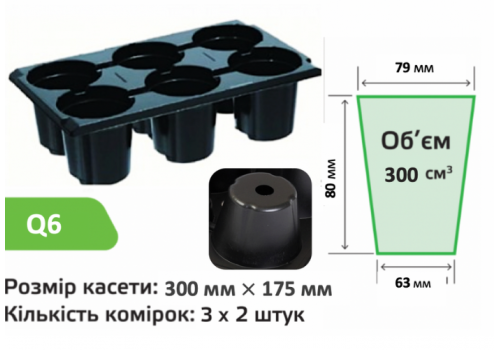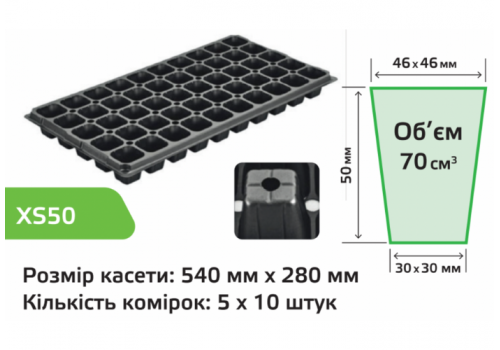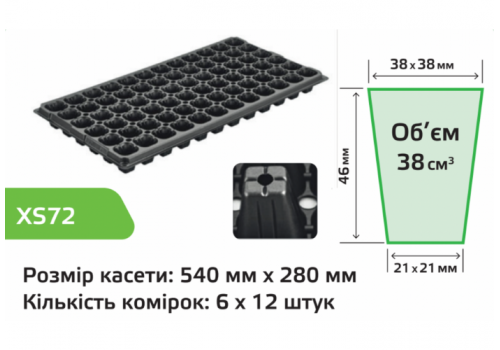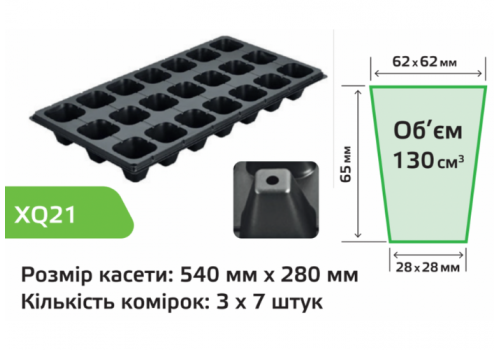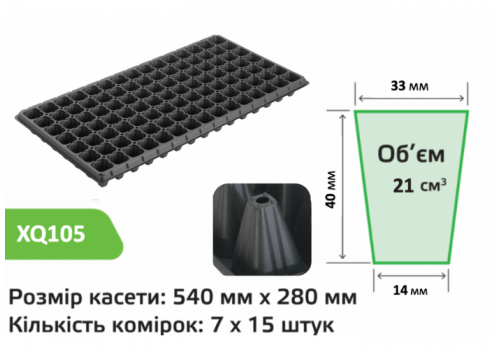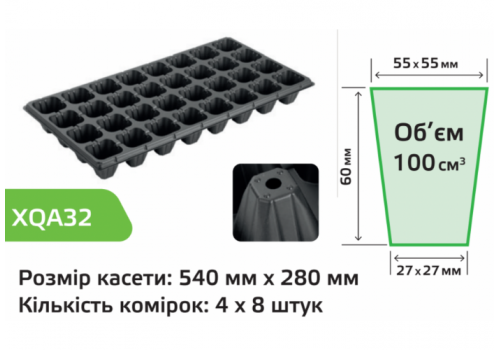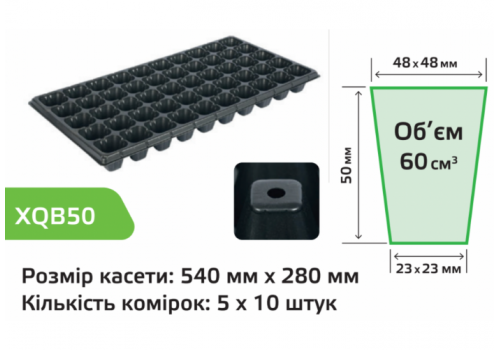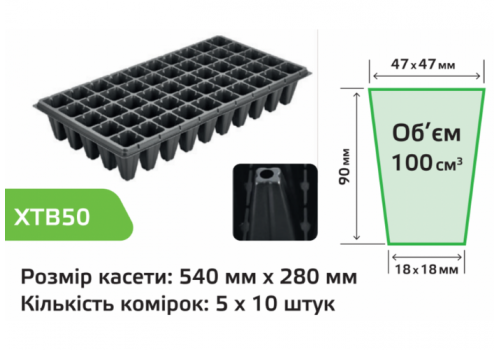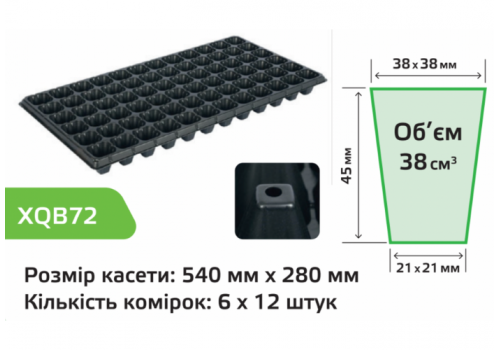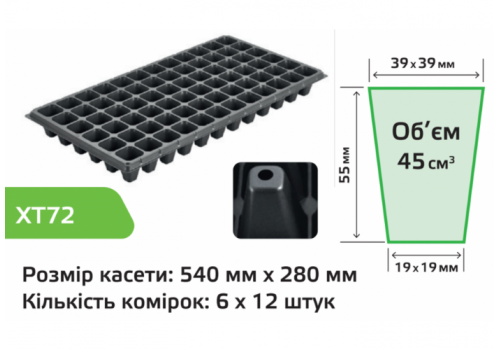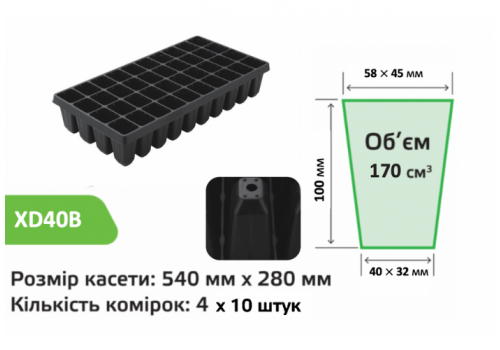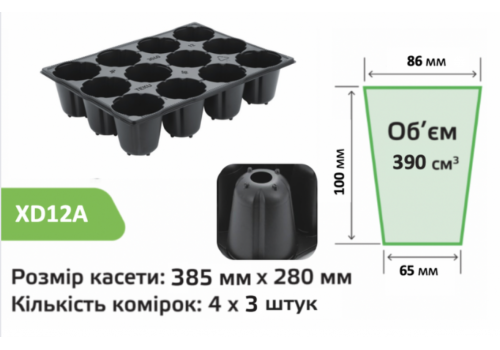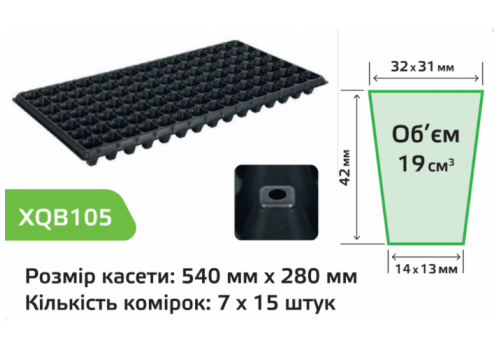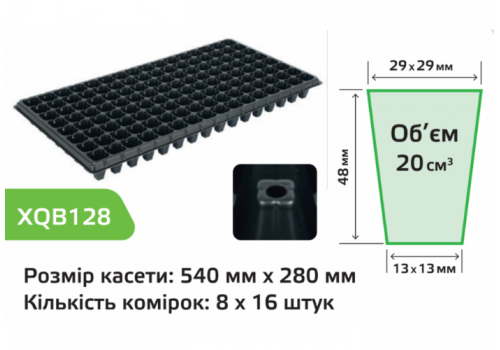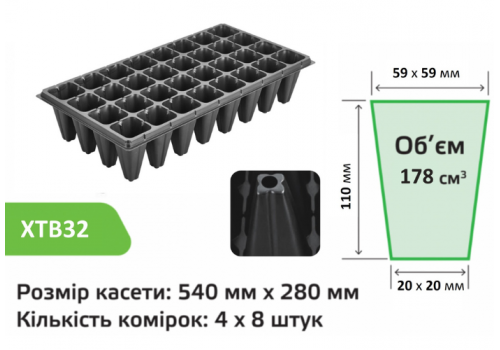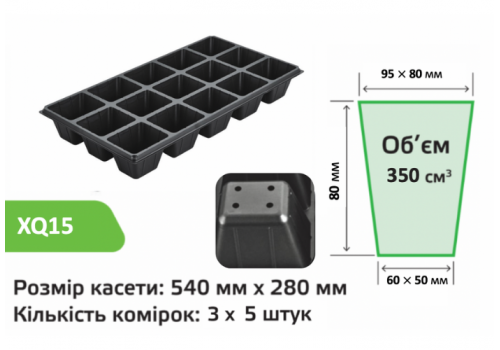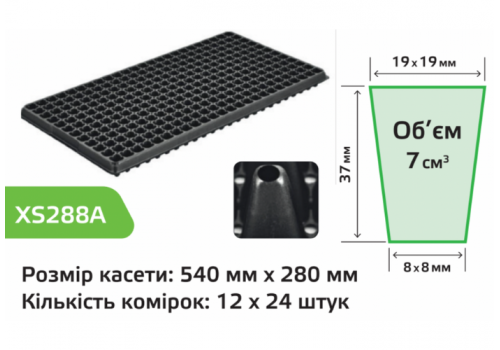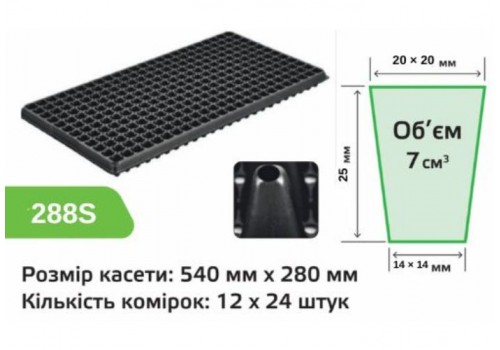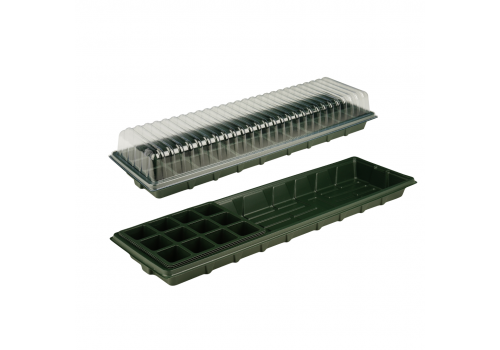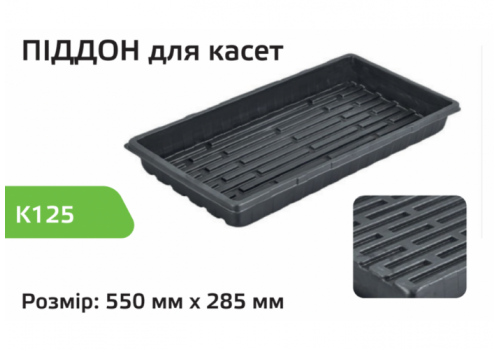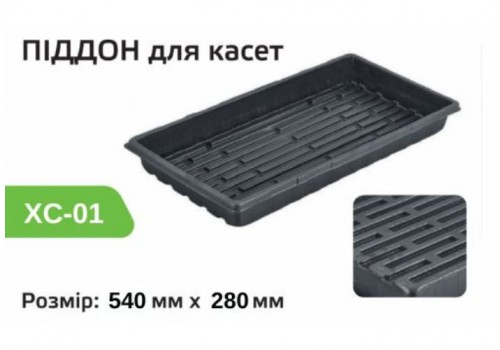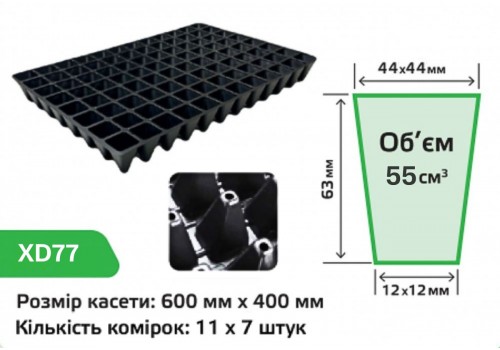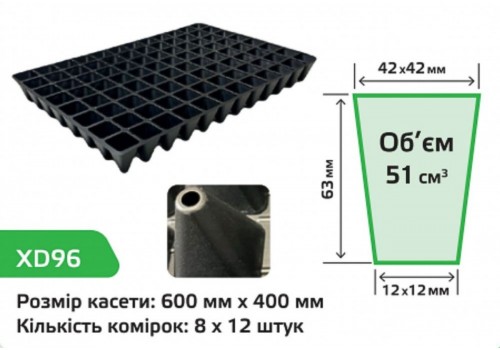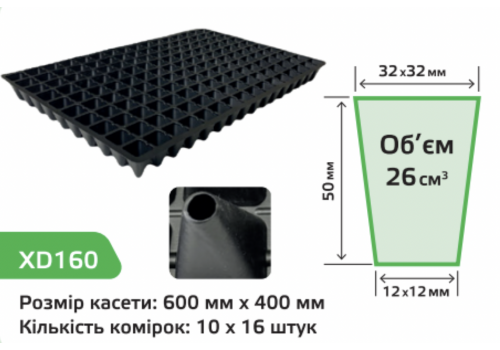Cassettes of size 54x28 cm (Dutch standard)
40x60 cm cassettes (Poland)
The Best Seedling Trays. Tips for Choosing and Benefits of Use
Seedling trays are special containers used for growing plant seedlings before their transplantation into open soil or larger containers. Seedling trays provide optimal conditions for plant growth, including ventilation, stability, and protection from root system damage during transportation and transplantation. They help seedlings grow healthy and strong until they are ready to be planted in open soil or other containers.
Seedling trays have several advantages compared to other containers:
- They create optimal and consistent conditions for growth – each plant grows in an individual cell and receives sufficient light, water, and nutrients;
- They accelerate seedling development, ensuring the formation of a robust root system;
- They eliminate the need for pricking out seedlings;
- They protect the root system from damage during transplantation and transportation;
- They promote rapid plant adaptation after transplantation;
- They improve seedling quality (all sprouts are uniform), thereby increasing yields;
- They isolate plants from each other, provide proper ventilation, and reduce the risk of diseases;
- They simplify accounting and care for seedlings;
- They help to compactly arrange seedlings (150 to 300 plants per m²) and efficiently use space, allowing for additional savings on secondary resources;
- They are easy to transport, saving time and effort.
TM Agreen has a dealer network throughout Ukraine. You can purchase high-quality plastic seedling trays wholesale and retail. Our products are eco-friendly, durable, sturdy, and flexible. They will reliably serve you for years.
Main Features
When choosing seedling trays, pay attention to the following characteristics: material of the product, wall thickness, tray dimensions, cell volume, depth, shape, number of cells, and the presence of a lid and tray.
Various types of plastic are used to manufacture seedling trays:
- Polyvinyl chloride (PVC) – inexpensive but fragile; contains harmful chlorine and has a strong smell;
- Polypropylene (PP) – quite durable but cannot withstand very high (over 50°C) temperatures or direct sunlight;
- Polyethylene terephthalate (PET) – strong and flexible, lasts long, but due to increased flexibility, trays with seedlings are inconvenient to carry;
- Polystyrene (PS) – characterized by increased strength and resistance to adverse factors, safe for health.
The durability of the product depends on the material and its resistance to adverse environmental conditions. Agreen trays are undoubtedly distinguished by their quality as they are made exclusively of polystyrene.
Wall Thickness
Wall thickness can vary from 0.5 to 1.1 millimeters. The strength of the walls depends not only on their thickness but also on the quality of the material.
Dimensions
Agreen seedling trays come in several sizes:
Polish standard:
- 60x40 cm
Dutch standard:
- 30x17.5 cm
- 54x28 cm
- 38.5x28 cm
A wide selection of trays with varying cell volumes:
- 7 cm³
- 9 cm³
- 20 cm³
- 21 cm³
- 26 cm³
- 38 cm³
- 45 cm³
- 51 cm³
- 55 cm³
- 60 cm³
- 70 cm³
- 100 cm³
- 130 cm³
- 170 cm³
- 178 cm³
- 300 cm³
- 350 cm³
- 390 cm³
In the Agreen catalog, there are trays with various cell depths:
- 25 mm
- 37 mm
- 40 mm
- 42 mm
- 45 mm
- 46 mm
- 48 mm
- 50 mm
- 55 mm
- 60 mm
- 63 mm
- 65 mm
- 80 mm
- 90 mm
- 100 mm
- 110 mm
The depth of the cell should be selected based on the strength of the plant's root system. If a seedling with a robust root system is planted in a small cell, it will grow poorly and appear weak.
Tray cells can have various shapes:
- Rectangular or square (cubic) – suitable for plants whose root systems spread wide and branch significantly;
- Round (cylindrical) – most convenient for planting in the soil;
- Conical – recommended for plants whose roots grow deep; ensures easy removal of seedlings from cells without damaging the root system.
In our catalog, you will find seedling trays with various numbers of cells:
- 6
- 12
- 15
- 21
- 32
- 40
- 50
- 72
- 77
- 96
- 105
- 128
- 160
- 288
Availability of a Lid
Seedling trays with a transparent lid can be used as mini-greenhouses. They create the most favorable conditions for seed germination and seedling growth. The lid is removed once it starts hindering the growth of the seedlings.
Mini-greenhouses are especially useful for growing demanding plants.
Availability of a Tray
In greenhouse operations, trays are placed on tables or racks. Plants are watered by spraying water, and any excess drains through the holes onto agro-fabric. Sometimes watering is done through the drainage holes, using a tray filled with water.
If plants are grown at home on a windowsill or table, it is also advisable to buy seedling trays with a tray to protect furniture from water.
Retail stores offer trays for Agreen seedling trays, sized 54x28 cm.
Features of Selecting Trays for Different Crops
When growing pepper seedlings in trays, choose containers with conical cells ranging from 50 to 350 cm³, depending on the variety (tall or short). It is important for the cells to be deep, with a height-to-width ratio of 3:1.
For cucumbers, watermelons, melons, and pumpkins, larger cells (200–300 cm³) are required, with a height-to-width ratio of 2:1. For celery, lettuce, and onions, small cells (30–50 ml) are sufficient, with a height-to-width ratio of 1:1.
Melons, peppers, and eggplants do not like transplantation; therefore, these plants are immediately transferred to open soil. In contrast, tomatoes require pricking for improved growth and strengthening. Tomato seeds are first sown in cells with a volume of 50–70 ml, and after the appearance of 2–3 true leaves, the seedlings are pricked into cells with a volume of 200–450 ml. Seedling trays for tomatoes should have fewer cells to ensure maximum light access for each plant.
Trays for cabbage seedlings (white, red, or cauliflower) are best purchased with trays, as this crop requires a lot of moisture. The recommended cell volume is 100–150 ml, with a height-to-width ratio of 2:1.
For flowers with small seeds (viola, petunia, daisy, lobelia), cells with a volume of 70–150 ml are suitable, but they should have a lid.
Trays for strawberry seedlings should preferably be cubic in shape with a depth of 50–60 mm, providing enough space for the expansive root system to develop.
A table can help make the right choice.
| Crop | Cell Volume, cm3 | Cell Depth, mm |
| Watermelons, melons, cucumbers, squash | 100–128 | 58–65 |
| Tomatoes, white and cauliflower | 25–100 | 55–85 |
| Chinese cabbage | 25–55 | 45–55 |
| Eggplants, peppers, onions | 40–90 | 40–90 |
| Celery | 55–100 | 50–85 |
| Strawberries | 55–128 | 55–65 |
How to Use Seedling Trays
First, wash the trays with a warm potassium permanganate solution and rinse thoroughly with clean water. Then fill the cells 2/3 full with soil and plant 2–3 seeds in each to ensure germination. Later, thin the seedlings, leaving one plant per cell.
Cover the seeds with soil and water them. Then cover the trays with plastic wrap and place them in a warm location. Remove the plastic once the first sprouts appear.
We have been engaged in wholesale product sales for over 20 years and are ready to work with both large companies and farming enterprises. Each of our offers is guaranteed to be beneficial for you.



